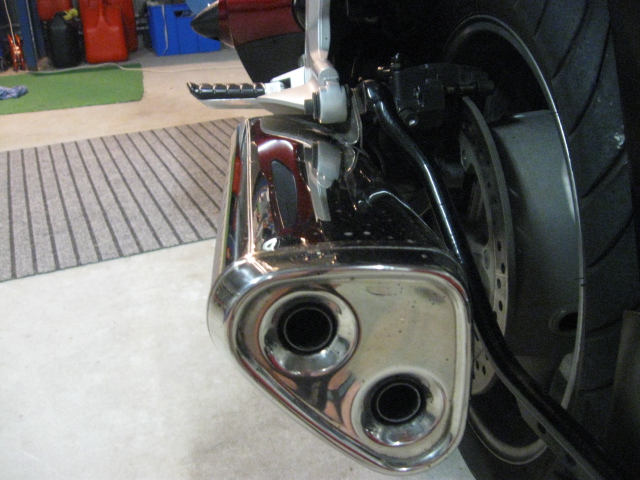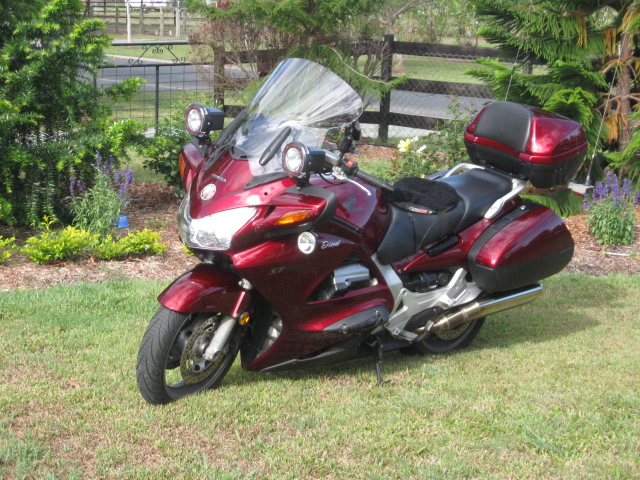Well - you saw in the previous posts that Stella was in need of a bath - so now was a great opportunity to give her a good scrub...
This is what $6000 looks like when not arranged properly...
And here it is getting a tub...
And here is the result...
And here she is in all her glory.... (I have since removed the Airhawk and Sheepskin seats)...
And here is the proud dad...
This has been a fantastic exercise, and the results, as they say, speak for themselves.
Now I have a very capable and reliable long distance weapon that is further customised to my needs and likes. You can see the V-STream windscreen fitted here as well. I think I am done - (yeah right!)
Cheers, Diesel
This blog chronicles events and milestones I experience in the ownership and operation of the famous Honda Pan European ST1300. You will read about from the day I bought it and the 1200km ride home, and you will see a whole community and website forum grow out of my passion to ride with like-minded legends. Read by the post's date so the story unfolds in the correct chronological order.
Thursday, December 6, 2012
Part 5 - Diesel's Spring Clean and Rewiring Project - Headlight Cut Out Bypass Switch Installation
Fitting the Headlight Cut-out Bypass Switch
With HID Lighting, it is said that they don't much like stopping and starting up again - but give longer life and better perfomance if they are able to be left on - much like flourescent lighting in office buildings.
Like many bikes, the ST1300 Pan European is set to have her headlights come on with the ignition, but then cuts power to them whilst the starter is being engaged, only to power the lights on again when the starter is released - giving that on-off-on pattern. (This is the case for Australian models at least - other countries may vary).
After much talking with two very good OzSTOC friends of mine and electronics genii to boot - Mal and Brock - they sent me over from Perth W.A., a mini loom that intercepts the current to the side stand - and this can be put through a relay on the headlight circuit.
The end result is that the headlight will stay off until the side stand is folded away. This in turn switches the headlights on.
 It involves wiring this relay a particular way...
It involves wiring this relay a particular way...
This great little mod allows me to turn on the ignition and wait for the FI light to go out and the fuel pump to prime before I hit it with the cranking power drain.
Thanks guys for a great piece of help.
After much talking with two very good OzSTOC friends of mine and electronics genii to boot - Mal and Brock - they sent me over from Perth W.A., a mini loom that intercepts the current to the side stand - and this can be put through a relay on the headlight circuit.
The end result is that the headlight will stay off until the side stand is folded away. This in turn switches the headlights on.
 It involves wiring this relay a particular way...
It involves wiring this relay a particular way...This great little mod allows me to turn on the ignition and wait for the FI light to go out and the fuel pump to prime before I hit it with the cranking power drain.
Thanks guys for a great piece of help.
Part 4 - Diesel's Spring Clean and Rewiring Project - Fitting and Wiring HID and Halogen Spotlights
Lights and Lighting Wiring
I selected the area above the nose cone to house the twin ballasts of the HID lighting equipment...

And I set up a negative (earth/ground) busbar to accommodate all the groundings for the front end.
I did this where I removed the now defunct speaker box (pictured is the one on the RHS)...
And I gave it a GOOD earth strap...
Also mounted the 55W halogen (under mirror) spotties' relay here too...
The 'brains' of the HIDs, I mounted in a similar position on the RHS....
Next was to put the apparatus / equipment in place....
Here, I bend the tabs back on the H4 HID base to make it fit to the H6 coupling in the headlight array...
I mounted a pair of good quality switches to independently operate the HIDs and Halogens...
And finally - the HID spotlights....
Now it was time to join all the dots - with wires!...
You can see above that I colour coded the wiring to keep everything in check at the various other points of the bike where the leads pop out.
Now to test the system..... Compare this......
To this....
Aaaah! SUCCESS!

Part 3 - Diesel's Spring Clean and Rewiring Project - ST1300 Pan European
What confronts a night rider in Australia?
I had to upgrade the lighting on my Pan European ST1300 because of the amount of night and early morning riding I do/plan to do. In Australia, when the sun goes down, the kangaroos come out to feed. Some years we have plentiful rain, and this is a little better for motorcyclists as opposed to the drought or dry years. Why??? Because by the shoulders of the roads are what we call tabledrains. All roads, highways, streets, etc have a crown, a camber, a shoulder, a gutter (if they are a suburban or city street, and/or a tabledrain if they are a country road, street or highway.
As kangaroos frequent the country roads and highways, the tabledrain is where they gather. The tabledrain is the lower part of ground next to country roads that all water is designed to end up in as it runs off the road. This is where the last remnants of water is found, and the grass is a little greener than the paddocks - hence drawing the marsupials near the road.
In abundantly wet years, there is enough vegetation all through the bush, and the tabledrain is not so inviting.
Wildlife does not recognise a road as a 'line of death' or a line of demarcation between boundaries - hence they appear 'dumb' but they never had primary school lessons teaching them about looking left and right - human toddlers are the same before they are 'educated'.
Soooooo (sorry to be long-winded about the explanation) - it is a good idea to have plenty of light, lighting up these tabledrains looking for wildlife. This can also include emus, goats, pigs, goannas, eagles, wombats, rabbits, foxes, lizards, crows, cattle, horses, sheep and camels - depending on whereabouts in Australia you are riding.
Finally - there even the concern of the big road trains and B-Double trucks/lorries that travel through the night and play 'roo bowling'. One has to be alert to the carcass' that may litter the roads early morning as they are quite a lump and quite a surprise when in the middle of the road through a curve or over a rise.
For a while, I had thought of a HID upgrade to my headlight array to keep the road filled in when you have to dip your lights for oncoming traffic. I am always conscious that there could be a marsupial carcass or severe pot hole in the road in that 'no man's' land, and it used to cause me concern. The HID installation as follows allayed a lot of this concern.....
Subscribe to:
Posts (Atom)





























